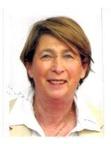Dorothea Shefer-Vanson's Blog, page 19
December 3, 2021
Back to Earth

After two weeks in California, with all its delights and attractions, it is a relief to be back in the humble abode that is our home in Israel. In California everything, or almost everything, is large. Most of the homes we visited are grand, the people generous and hospitable, and the wide streets and huge stores provide an array of goods and facilities that keep the mind on constant alert for the next attractive bargain or delightful display.
Our visit coincided with the run-up to Christmas (only another month to go), so fairy lights and decorations were everywhere to be seen, and the eternal Christmas songs assailed our ears in every public space. There was no mention of Chanuka unless we were in the home of Jews or former Israelis. As far as the latter are concerned Chanuka consists of men and women reciting the blessing and lighting the menora together, in an egalitarian approach which I personally found refreshing, singing a few songs, whether the first verse of the traditional Maoz Tzur or songs remembered from their kindergarten days, followed by feasting on such traditional fare as latkes (potato pancakes) and doughnuts. In my Germanic family tradition such fattening items were eschewed, and our traditional Chanuka treat coincided with that common throughout Europe at Yuletide — gingerbread biscuits.
Part of the relief at being back home is that everything seems to be in proportion. Admittedly, in Israel we are short of space and our roads are narrower and shorter than those in California, but at least here the restricted dimensions oblige drivers to slow down and pay greater attention to what is happening around them. I never dared to take the wheel in California, finding the breadth, width and speed of the roads and the other vehicles too intimidating. One acquaintance there expressed amazement at my timidity, declaring that if I could drive in Israel I must be able to drive anywhere, but that was certainly not the case for me.
Big is beautiful, so the saying goes, and if that is true than California is certainly beautiful, with its huge expanses, mountains and terrific beaches and coastline. But Israel has all those things (except huge expanses), albeit on a smaller, more practical and more human scale (as well as a few other things besides). Far be it from me to denigrate the wonders and advantages of the New World, but it seems to me that the old world suits me better.
November 26, 2021
Living the American Dream
Spending time in Orange County, adjacent to Los Angeles, gives one a new perspective on life as it is lived by former Israelis in America. like all other ethnic groups, they tend to gather together in groups, associate socially with one another, speak their own language and maintain their traditional habits.
So although it came as something of a surprise to find that our son and his partner seem to associate almost entirely with former Israelis, what was even more surprising was to discover how varied their lives were. Some of them have done well, live in grand houses (interiors done by interior designers, everything in white), while others live in more modest apartments. These differences don’t stop them from associating with one another, and hosting one another ion the many and varied occasions that life in America, offers — especially if you’re a former Israeli. Whether it’s Thanksgiving or Chanukah, guests from abroad or just to have people round to view a film in one’s super-confortable viewing room (with a real popcorn machine on hand to serve guests), no opportunity to gather and make merry is missed.
I know that somewhere along the way work is done and a living gets to be made, but that seems merely incidental to the main concern, namely, getting together to chat in Hebrew, eat hummus, jakhnun and shakshuka, which are all available to be bought or homemade here, though of course on Thanksgiving, that truly American festival, the traditional fare is more or less universal.
Although they have left Israel for good, and made a success of their life in America, most of the Former Israelis we have met here still hanker for the country they have left, making frequent visits there to see family and friends, and even owning property there. Their children, whether born here or there, bear Israeli names, and I wonder how a child called Suf or Bar copes with the puzzled looks they doubtless encounter each time they have to give their name e.g., in Starbucks when ordering coffee). i know from our own experience how difficult it is for the average American to cope with my OH’s name, Yigal.
And apropos Starbucks, our daily breakfast experience has taught me that nothing beats their grilled cheese sandwich. But while there’s a lot to be said for the American way of life, i’m looking forward to being able to buy fresh bread and challah from the Angel bakery in Jerusalem. and of course to being back together with my friends and family in Israel.
November 24, 2021
California Dreaming
Coming to the U.S.A. from Israel (or Europe, come to that) one of the first things that strikes you is how big everything (and everyone) is. Well, in California, where i am just now, everything is even bigger. Not necessarily better, but definitely bigger
The roads and freeways are longer and wider, the vehicles that ride along them at breakneck speed are boader and longer, the car parks are larger (and you don’t have to squeeze into tiny spaces to make room for others). in fact one of the salient features on our car in Israel is that the wing mirrors fold away when the car is switched off. No need for any such frolicsome space-saving tricks here in good old California.
Despite dire predictions in the media, we did not find that the vast majority of Californians are obese or of immense proportions. One or two are, here and…
View original post 311 more words
November 18, 2021
California Dreaming
Coming to the U.S.A. from Israel (or Europe, come to that) one of the first things that strikes you is how big everything (and everyone) is. Well, in California, where i am just now, everything is even bigger. Not necessarily better, but definitely bigger
The roads and freeways are longer and wider, the vehicles that ride along them at breakneck speed are boader and longer, the car parks are larger (and you don’t have to squeeze into tiny spaces to make room for others). in fact one of the salient features on our car in Israel is that the wing mirrors fold away when the car is switched off. No need for any such frolicsome space-saving tricks here in good old California.
Despite dire predictions in the media, we did not find that the vast majority of Californians are obese or of immense proportions. One or two are, here and there, but I’d say no more than the average population in Israel. which, when I come to think about it is pretty amazing as wherever one goes to eat the food portions are huge, the drinks are five times the quantity of a ’regular’ cup or mug anywhere else in the world, and generous helpings are taken for granted. As we have neither a fridge nor a microwave in our (very spacious) hotel room, we have no alternative but to leave our excess food behind. If we were at home in Israel the leftovers would be packed up and taken home to be eaten at the next meal or two.
Generosity is the name of the game here. People are civil, hold doors ooen for one another, greet perfect strangers when they share an elevator, and are quick to help an old lady like myself to pick up any fallen item such as a bag or a purse. In a few days’ time there will be Thanksgiving, with its attendant Black Friday and Super Sunday wild shopping days followed by the run-up to Xmas shopping. Carols and Xmas songs are already pouring out of the sound systems in the various shoppping precincts, and we will do our best ro stay as far away from those places as is humanly possible.
Meanwhile, we are doing our best to enjoy the laid-back ambience of this part of the world, even though the weather is getting noticeably cooler, so that bathing in the sea is out of the question for anyone but the hardiest souls. Still, our visit yesterday to the justifiably renowned Getty museum was an inspiring experience, and there are still more delights to be explored.
But now the delights of the nearby outlets center await us, and we will make our way there anon, to see what bargains we can find.
November 11, 2021
A Silent Film by Mozart
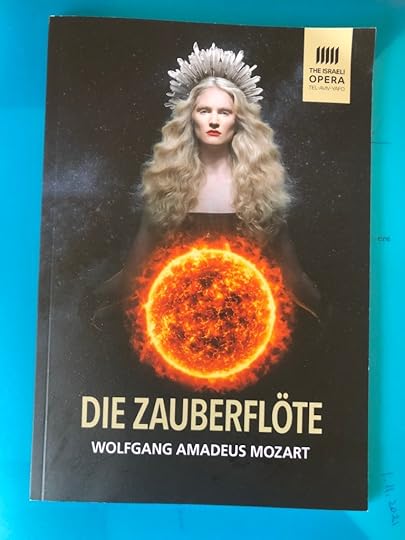
A performance of ‘The Magic Flute’ in the evening led us to spend a day in Tel Aviv, enjoying the view of the sea from the restaurant on the sun-drenched promenade, partaking of the aesthetic delights on offer at the Tel Aviv Museum (including the delicious cakes in the coffee-shop there) and ending with a highly innovative performance of the opera.
That opera (or ‘Singspiel’ as it was originally called – a kind of hybrid between a musical and an opera) is one of the most popular and most often performed all over the world. Hence, it is very difficult to put on a production that is entirely fresh and novel. As a friend involved in the business of producing opera told us, they’re heartily sick of that particular opera. Luckily, we’re not in the business, so are still able to enjoy it. It’s true, everyone knows the music and the rather convoluted plot, but l haven’t yet tired of Mozart’s music and inventiveness.
The stage of the Tel Aviv Opera was occupied by a huge screen upon which animated patterns and images of various kinds were projected, while live singers either moved around at the front of the stage or seemed to be embedded at different points of the screen as they sang and emoted in accordance with the music and the plot. Having a live orchestra in the pit gave the occasion the sense of being at a ‘normal’ opera performance, with its added dimension of depth and intensity. Incidentally, this and all the other (and additional) performances in Tel Aviv were completely sold out.
The underlying concept of the production was that of the silent films of the 1920s (the name of the company that produced the animated segments on the screen is ‘1927’ – the year the first talking film, ‘The Jazz Singer,’ was shown). The character of Papageno, the hapless bird-catcher, was a clear imitation of Buster Keaton, with his idiosyncratic facial makeup, expressions, attire and general demeanour clearly echoing those of the actor who featured in many outstanding silent films of the 1920s and 1930s. The costumes and gestures of the other characters also echoed those evident in the films of that period.
As with those films, at times the action on the stage was accompanied by an interlude played on a solo piano (but always playing music composed by Mozart, albeit for other works), alongside captions on the screen summarising what would ‘normally’ be lengthy dialogues in German (or Czech, as was the case when we attended a performance in Prague some years ago). The fonts used for the dialogue differed in accordance with whoever was speaking, adding another dimension of humour and interest to what was going on.
The animation incorporated elements of fantasy as well as imaginative depictions of scenes and situations. Thus, Papageno was accompanied by an animation black cat, who turned out to play a (silent) part in the action, constituting another focal point of attention and, yes, you guessed, humour. Every action, thought, emotion or experience conveyed in the music and the narrative also found expression in the animation on the screen, at times in glorious technicolour, at others in stark black and white, introducing cultural elements and associations from a myriad of different (but relevant) contexts, but always imaginative, amusing and thought-provoking.
Elements from comic strips also found their way into the animation on the screen, so from time to time the audience was treated to such expressions as ;’Thwack!’ and “Ka-boom,’ using the fonts associated with those comic strips, to emphasize what was being depicted by the music and the singers.
Altogether, this production created something new and wonderful but still remained faithful to the original vision of Mozart and his lybricist Schikaneder or, as one of the animation team pronounced “What we’ve created is, in effect, a silent film by Wolfgang Amadeus Mozart.”
November 4, 2021
Julius Matthias –Hope Reborn
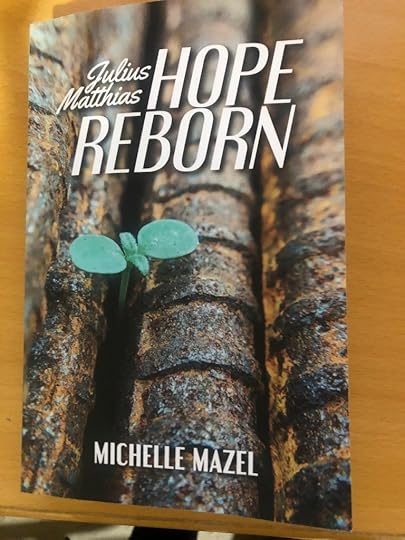
The photo of American soldiers in front of the newly-liberated Eiffel Tower in the summer of 1944 forms the frontispiece of this book by Michelle Mazel, setting the scene for what is to follow.
Dr. Julius Matthias, the chief protagonist of Michelle Mazel’s previous book, has managed by the skin of his teeth to escape deportation by the Nazis from his hometown in Transylvania. His wife, who had refused his entreaties to leave the town together with him, was shot and killed by the invaders during the round-up of the Jews of the town. Many years before that Matthias had sent his grown-up children to France to study, and so, left on his own, he manages for many months to make his way on foot through the fields and forests of Europe, eventually reaching Geneva, where he has friends and a bank account.
Switzerland, relatively untouched by the war that has ravaged most of Europe, and is still being waged in parts of it, presents a stark contrast to the privations and dangers he has left behind. After a period of recuperation and restoration, during which he learns that his erstwhile mistress has died, leaving him a wealthy man, he decides to travel to Paris, hoping to meet up again with his children, from whom he has not heard for several years.
He resolves to make the journey by car, and at the last minute is persuaded by his friends and hosts to allow a young woman of their acquaintance to accompany him. On the way they encounter some Nazi soldiers who have been separated from their unit but still constitute a threat, and it is only the quick thinking and crack shot of his unknown companion that saves Dr. Matthias’ life. His companion does not give him much information about her past, but they soon establish a close relationship, so that when they reach Paris she is invited to stay with him in the spacious apartment of his friends there.
The rest of the book concerns Matthias’ efforts to trace his children, and especially his eldest daughter, Elisabeth, who had studied medicine in Paris and even worked there but of whom no trace could be found. France is gradually returning to normal after five years of German occupation during which to be a Jew meant to be subject to constant danger of arrest and deportation. How people, whether Jew or Gentile, managed to survive was partly a matter of luck, keeping a low profile, managing to live on the meager rations that were allocated, or profiting from the black market. Every individual Matthias encounters in his attempt to find his children has a story to tell, ranging from the elderly Jewish couple who are his generaous hosts in Paris to the Polish-Russian forgers who fabricate false documents as required, and the farmers in the village where he finds the young grandson of whose existence he had been unaware. Membership in the Resistance seems to have been all-pervasive – at least wmong those who had survived.
Meanwhile, Matthias and his travelling-companion, whom he now knows as Lily, have become lovers, and they begin to make plans for their future together. Matthias’ older sister, Anni, travels from America, where she has been living for many years, and helps him in his quest to find his children. Since this search is the crux of the novel, I won’t give the ending away by disclosing what ensues, but suffice it to say that the novel does an excellent job of describing the desolation and damage caused by the war that uprooted, exiled and murdered millions of people, severing bonds of friendship and family, causing untold misery and leaving behind a trail of broken lives.
Nevertheless, the book ends on a note of optimism, as lives are rebuilt and the hope of the establishment of a country where Jews might live in peace begins to emerge.
October 28, 2021
Coffee, East and West
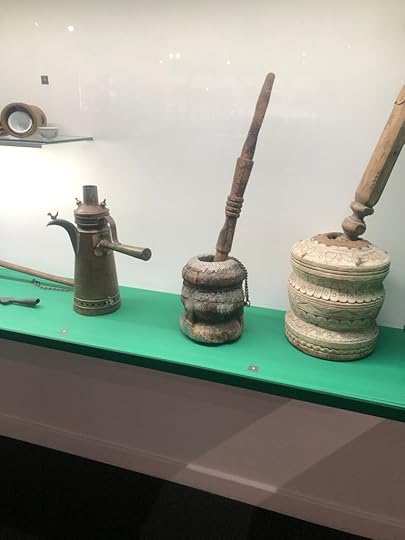
One of Jerusalem’s lesser-known gems is the Museum for Islamic Art, a handsome building situated not far from the Jerusalem Theatre complex and the President’s residence. As well as exhibiting a fine array of objects of Islamic art it houses a unique collection of clocks and watches amassed by the late David Solomons. A large part of that collection was stolen from the museum some forty years ago, but by a series of strange events and coincidences was returned to its rightful home about ten years ago.
But that is not what brought me to its portals. The museum also hosts changing exhibitions on allied subjects, and the current one, entitled ‘Coffee, East and West,’ was enticing enough to induce me to visit it.
Alongside the wide variety of utensils – some purely functional, others more decorative, even ornate — used for the preparation of the brew, which are on display, are informative notices explaining its history and cultural associations.
Thus, the origin of coffee stems from Ethiopia where, so legend has it, a shepherd noticed that after his goats had eaten certain berries that grew locally they would leap about energetically. He decided to try them for himself, and found the taste to his liking. The process of grinding the beans and boiling them in water developed in the region, eventually spreading to the Arabian peninsula.
Initially, coffee was drunk only by men, whether in the home or, later, in coffee-houses, throughout the Islamic world, where women rarely left their house (or tent) and certainly did not participate in public life in any way. The process of preparing coffee entailed the production of special implements, first for grinding the beans into a powder and then for cooking or boiling the liquid to make it more palatable. The exhibition contains a fascinating video of a Beduin grinding the beans in a rhythmic, almost musical way, and this is also echoed in the sound-track to part of a delightful animation video depicting the history of coffee and the journey it has taken to reach the Western world.
Inevitably, the custom of preparing and drinking coffee spread throughout the Ottoman Empire, reaching the dusty region known as Palestine. The coffee-houses were frequented by the local male inhabitants, both Moslem and Jewish, though some rabbis disapproved of the habit-forming brew.
Travellers as well as the failed attempt of the Ottoman army to conquer Vienna brought the drink to Europe in the seventeenth century, and the institution of the coffee-house became increasingly popular. Once again, it was only the male of the species who frequented these establishments, and the idea of women sitting in a public place and drinking coffee was generally frowned upon, Johann Sebastian Bach even went so far as to compose an amusing cantata, the ‘Coffee Cantata,’ in which a father forbids his young daughter to go to the coffee house (one can listen to the music on headphones in the exhibition). The daughter finds a way around this by agreeing to get married, convinced that she will be able to persuade her husband to let her indulge in her passion for coffee. Women were apparently responsible for introducing a less potent form of coffee, mixing it with milk and sugar.
As the custom of drinking coffee spread throughout Western Europe the devices for its preparation and consumption became ever-more elaborate. The exhibition displays delicate porcelain coffee sets and jugs, some with hand-painted decorations, made by the foremost European producers of china. The twentieth century has brought a plethora of refinements in the production of the coffee we drink, with percolators, espresso machines and all manner of electric and electronic devices. Whether we use a machine to make our coffee or simply take a spoon of powdered coffee and mix it with boiling water in a cup, it’s a far cry from the pestle and mortar with which the potent brew originated.
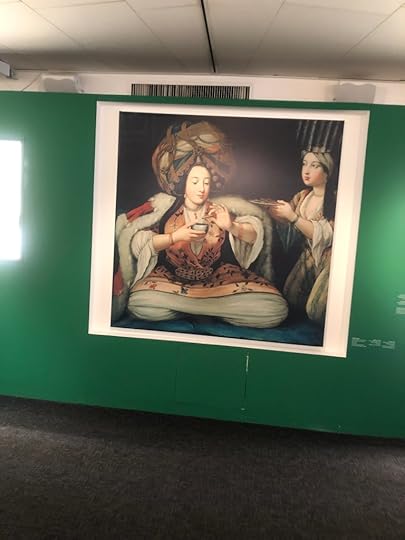
Two things were lacking in the exhibition: the enticing aroma of the drink and the ability to get a cup of coffee there. Notwithstanding its defects, the exhibition is interesting, aesthetic and informative, and it’s certainly worth a visit.
October 20, 2021
England, Their England
.
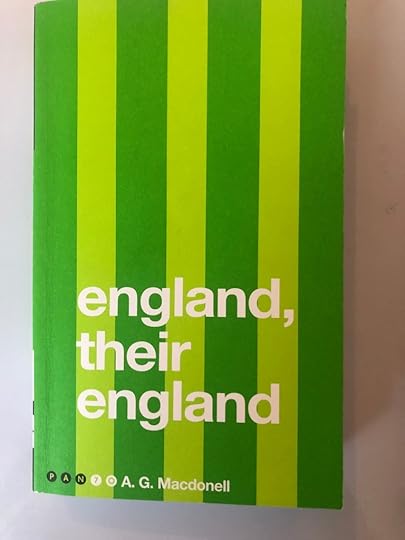
This book by A.G. Macdonell aims to provide an account of life in England in the 1930s, i.e., in the period between the two world wars. Despite claiming that it is not a book about war, the first chapter describes a particular battle that took place in the First World War, using it as an opportunity to mock, deride and defame the structure, function and comportment of the various ranks of the British army, and the officer corps in particular.
.The reader is able to witness the efforts of one Donald Cameron to study the nature of the British national character. He is a young man who has abandoned his late father’s failed farm in bleakest Scotland and makes his way by train south to London. Wanting to be a writer, he finds himself undertaking various free-lance journalism tasks, and this sends him to a number of areas and situations in and around. London, in his quest for ‘local colour.’
One of his first assignments is to cover – and participate in – a cricket match between some upper-class chaps he meets while seeking employment as a journalist, and a team of villagers somewhere in Essex. His account of the game, which was supposedly alien to him, and the behaviour of the participants, which consisted mainly of going off singly or in pairs to the local pub, which opened and closed according to the whim of its owner rather than the official opening hours in effect at the time, reads more like an account of a Commedia del’Arte performance, replete with comic entrances and exits, flippant remarks and a fair amount of bullying and blustering from all concerned (but mainly from the ‘toffs’ from London).
Another, similarly facetious account, accompanies the chapter devoted to a football (soccer) match played in a London stadium between two teams which have been longstanding rivals. His description of the behaviour of the supporters of the rival teams, both inside and outside the stadium, seems to be in accord with the behavious of British football fans today.
There are accounts of fancy dinner parties attended by such worthies as Sir Ethelred Ormerode, Captain de Wilton-ffallow and the beautiful Esmeralda d’Avenant. The latter seeks to befriend the author after mistakenly assuming that he is a distinguished journalist who can provide her with publicity in his newspaper. And so it goes on, with the facetious tone being maintained throughout the book, and the inimical British way of life with its class system, antiquated rites and often meaningless rituals (especially those associated with sport) being held up for constant albeit gentle ridicule.
The book was considered a classic in England in the 1930s, but to my mind it has not withstood the test of time.
October 13, 2021
Turning the Clock Back
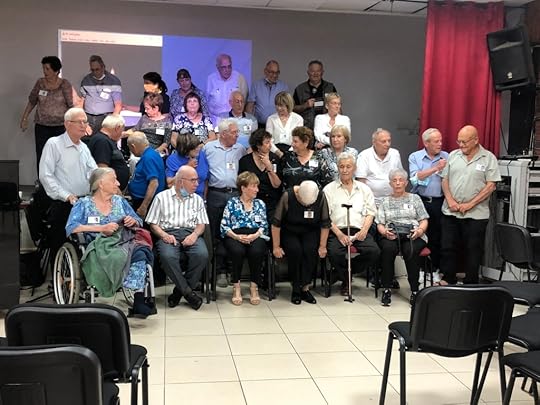
A reunion of people who, like my husband, were born in 1940, i.e. now aged eighty, might sound over-optimistic, but these were no ordinary people. These were men and women who were born and brought up in Kiryat Haim, a settlement situated on the coast slightly north of Haifa. Kiryat Haim was founded in the early 1940s by people, halutzim, idealists who had come to Israel from Russia and Poland to help build the Jewish State. They were all Labour Party stalwarts and their offspring attended the local high school and became devoted members of the Working and Studying Youth Movement (Noar Oved veLomed),
Inevitably, the reunion organisers were at pains to point out the many gaps and losses in their number, but nonetheless, some fifty former members of the youth movement, accompanied by spouses, came from all corners of the country (and one even from the USA) to participate in the event. Most of them seemed relatively sprightly, though one participant was in a wheelchair, one or two of them were using walking sticks, and of course there were many bent backs and instances of bald heads or scanty grey hair, but on the whole the overall impression was of a crowd of mentally and physically active pensioners with a lively sense of humour. These were people who had been involved in every stage of Israel’s existence, and represented the best of its population.
Every participant was equipped with a tag bearing his or her name and a photo of themselves from the time when they had all been eighteen years old, just about to enlist in the army or to embark on whatever path in life they had chosen. There were many exclamations of surprise and delight as the old-timers peered at one another’s name tags and rediscovered one another, many of them bearing very little resemblance today to their youthful selves.
The event was well-organised, providing a welcome spread of coffee and cake as everyone arrived after having braved the traffic and traffic jams on the way to the meeting place. After allowing an hour for everyone to greet and re-establish old friendships, a session was devoted to speeches by the organisers, who had dug out the minutes of the meetings held in the youth movement and read out reports of the activities undertaken at the time. Others of the participants went up to the microphone and shared their thoughts and reminiscences. One participant had even written a poem for the occasion. All this occasioned much appreciation, laughter and friendly banter as long-buried memories were brought back to life.
As is essential on such occasions, a generous buffet lunch was provided, offering a wide variety of aesthetically-presented salads and quiches, served on recyclable plates and cutlery, followed by a delectable dessert. Cold drinks (but no alcohol) were on hand, and it was a joy to see the senior citizens tucking into their food with gusto as they chatted to one another, trying to catch up on the events of the sixty years in which they had not had contact with one another.
As people ate a series of photos from those youthful years appeared on a large screen at the back of the hall, and people took pleasure in recognising themselves and one another. In those far-off days they all wore shorts and singlets, though none of them would venture to wear that kind of attire today. The meal was followed by a recital by one of the participants, Eitan Vardi, who is a veritable virtuoso on the recorder – playing and explaining the various categories of instrument, all of which were made in Kibbutz Geva. Accompanied by a talented young musician on the piano, he demonstrated and talked about the pieces he played for almost an hour. Before moving on to the next activity, everyone was summoned to the stage to pose for a group photo.
And finally came the pièce de resistance, as song sheets were handed out to the assembled throng and, led by Eitan Vardi on the recorder, roared out the songs they had sung as youngsters. A few insisted on singing the International and the movement’s anthem. Some of the participants were visibly moved and could hardly hold back the tears as they sang. The final song on the song sheet was one that was composed only at a later date, a touching and surprisingly optimistic song called ‘The Party’s Over’ by Naomi Shemer. But I must confess it was truly inspiring to hear the crowd of eighty-year-olds enthusiastically sing the words ‘Time to get up the next morning and start all over again.’
Let’s hope they all find the strength to do just that.
October 7, 2021
The Anatomy of a Spy; a History of Espionage and Betrayal
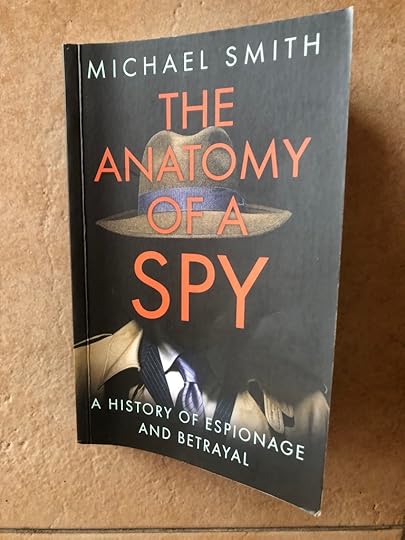
It is very rare for a book to elicit loud exclamations of surprise, delight or amazement from me while I’m reading it, but this did indeed happen on several occasions while I was engrossed in this remarkahle, well-researched and enlightening book by Michael Smith.
After providing a detailed analysis of the biblical story of the betrayal of Samson by Delilah, providing insights and hypotheses as to what happened and why, Michael Smith gives the reader a series of detailed and insightful chapters on the way real-life spies have operated and what their motives were for doing so. With chapters entitled ‘Sexual Relationships,’ ‘Money,’ and ‘Patriotism,’ amongst others, the reader is introduced to the characters who have worked to pass on the secrets of their own or other countries in European, Asian and American history and in modern times.
The author has had access to a vast array of sources, both official and unofficial and so, using these as well as his extensive knowledge of modern history, he gives the reader a fascinating glimpse into the lives and minds of a wide range of individuals who have engaged in the undeniably risky occupation of spying. Giving the occasional nod to the James Bond character in the novels of Ian Fleming, Michael Smith reveals the ways in which the various national intelligence agencies managed their secret agents, thereby obtaining information they considered damaging to countries perceived as a threat.
This was particularly the case during war-time, and the information obtained by the British and American intelligence services during the two world wars, provided by foreign nationals as well as their own agents, proved invaluable in determining the ultimate victory of the Allied forces. On the other hand, the spies who worked to undermine the West, such as the ‘Cambridge Five’ in England and agents working for the Russians in Germany, the USA and elsewhere, caused untold harm to those countries, passing on invaluable information and essentially enabling Russia to develop its own nuclear arsenal. On the basis of the intelligence provided by a ‘mole’ inside the Russian military establishment President Kennedy was able to call Khruschev’s bluff over the Cuban Missile Crisis in 1962, bringing the threat of a worldwide nuclear conflagration to an end.
A particularly telling chapter near the end of the book recounts the way the Russians manipulated social media, and thus public opinion in the USA, to discredit Hillary Clinton in the 2016 Presidential election. By investing massive and sophisticated resources, the Russians were able to get their preferred candidate elected, despite his obvious personality, intellectual and administrative flaws.
Altogether, this book provides an eye-opening account of the ways in which spies have operated through the ages, their motivations for doing so and the benefits (or detriments) thus gained by the countries for which they worked. It is altogether a fascinating, well-written and instructive book which I highly recommend.


